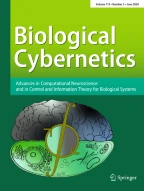Abstract
We present a model of sensory segmentation that is based on the generation and processing of temporal tags in the form of oscillations, as suggested by the Dynamic Link Architecture. The model forms the basis for a natural solution to the sensory segmentation problem. It can deal with multiple segments, can integrate different cues and has the potential for processing hierarchical structures. Temporally tagged segments can easily be utilized in neural systems and form a natural basis for object recognition and learning. The model consists of a “cortical” circuit, an array of units that act as local feature detectors. Units are formulated as neural oscillators. Knowledge relevant to segmentation is encoded by connections. In accord with simple Gestalt laws, our concrete model has intracolumnar connections, between all units with overlapping receptive fields, and intercolumnar connections, between units responding to the same quality in different positions. An inhibitory connection system prevents total correlation and controls the grain of the segmentation. In simulations with synthetic input data we show the performance of the circuit, which produces signal correlation within segments and anticorrelation between segments.
Similar content being viewed by others
References
Baldi P, Meir R (1990) Computing with arrays of coupled oscillators: an application to preattentive texture discrimination. Neural Comput 2:458–471
Biederman I (1988) Aspects and extensions of a theory of human image understanding. In: Pylyshyn Z (ed) Computational processes in human vision. Ablex, New York, pp 370–428
Buhmann J (1989) Oscillations and low firing rates in associative memory neural networks. Phys Rev A 40:4145–4148
Eckhorn R, Bauer R, Jordan W, Brosch M, Kruse W, Munk M, Reitboeck HJ (1988) Coherent oscillations: a mechanism of feature linking in the visual cortex? Biol Cybern 60:121–130
Engel A, König P, Kreiter AK, Singer W (1991a) Interhemispheric synchronization of oscillatory neuronal responses in cat visual cortex. Science 252:1177–1179
Engel A, Kreiter AK, König P, Singer W (1991b) Synchronization of oscillatory neuronal responses between striate and extrastriate visual cortical areas of the cat. Proc Natl Acad Sci USA 88:6048–6052
Freeman WJ (1978) Spatial properties of an EEG event in the olfactory bulb and cortex. Electroencephalogr Clin Neurophysiol 44:586–605
Geman G, Geman S (1984) Stochastic relaxation, Gibbs distributions, and the Bayesian restoration of images. IEEE Trans Pattern Anal Mach Intell PAMI- 6:721–741
Geman G, Geman S, Graffigne C, Dong P (1990) Boundary detection by constraint optimization. IEEE-PAMI 12:609–628
Gray CM, Singer W (1989) Stimulus-specific neuronal oscillations in orientation columns of cat visual cortex. Proc Natl Acad Sci USA 86:1698–1702
Gray CM, König P, Engel AK, Singer W (1989) Oscillatory responses in cat visual cortex exhibit intercolumnar synchronization which reflects global stimulus properties. Nature 338:334–337
Hopfield JJ (1991) Olfactory computation and object perception. Proc Natl Acad Sci USA 88:6462–6466
König P, Schillen TB (1991) Stimulus-dependent assembly formation of oscillatory responses: II. Synchronization. Neural Comput 3:155–166
Koffka K (1935) Principles of gestalt psychology. Harcourt, New York
Lowe D (1985) Perceptual organization and visual recognition. Kluwer, London New York
Lytton WW, Sejnowski TJ (1991) Simulation of cortical pyramidal neurons synchronized by inhibitory interneurons. (preprint)
Marroquin JL, Mitter S, Poggio T (1987) Probabilistic solution of ill-posed problems in computational vision. J Am Stat Assoc 82:76–89
Moran J, Desimone R (1985) Selective attention gates visual processing in the extrastriate cortex. Science 229:782–784
Murthy VN, Fetz EE (1991) Synchronized 25–35 Hz oscillations in sensorimotor cortex of awake monkeys. Neurosci Abstr
Reitboeck JH, Eckhorn R, Pabst M (1987) A model of figure/ground separation based on correlated neural activity in the visual system. In: Haken H (ed) Synergetics of the brain. Springer, Berlin Heidelberg New York, pp 44–54
Rock I, Palmer S (1990) Gestalt psychology. Sci Am 263:84–90
Sato T (1988) Effects of attention and stimulus interaction in visual responses of inferior temporal neurons in macaque. J Neurophysiol 60:344–64
Schneider W (1986) Anwendung der Korrelationstheorie der Hirnfunktion auf das akustische Figur-Hintergrund-Problem (Cocktailparty-Effekt). Dissertation, Universität Göttingen
Schillen TB, König P (1991) Stimulus-dependent assembly formation of oscillatory responses: II. Desynchronization. Neural Comput 3:167–178
Sejnowski TJ, Hinton GE (1987) Separating figure from ground with a Boltzmann machine. In: Arbib MA, Hanson AR (eds) Vision, brain, and cooperative computation. MIT Press, Cambridge, pp 703–724
Sompolinsky H, Golomb D, Kleinfeld D (1990) Cooperative dynamics in visual processing. Phys Rev A 43:6990–7011; Global processing of visual stimuli in a neural network of coupled oscillators. Proc Natl Acad Sci USA 87:7200
Sporns O, Tononi G, Edelman GM (1991) Modeling perceptual grouping and figure-ground segregation by means of active reentrant connections. Proc Natl Acad Sci USA 88:129–133
Treisman AM, Gelade G (1980) A feature integration theory of attention. Cogn Psychol 12:97–136
von der Malsburg C (1981) The correlation theory of brain function. Internal Report 81–2, Abteilung für Neurobiologie, MPI für Biophysikalische Chemie, Göttingen
von der Malsburg C, Schneider W (1986) A neural cocktail-party processor. Biol Cybern 54:29–40
Wang DL, Buhmann J, von der Malsburg C (1990) Pattern segmentation in associative memory. Neural Comput 2:94–106
Wertheimer M (1923) Psychol Forsch 4:301–350
Author information
Authors and Affiliations
Rights and permissions
About this article
Cite this article
von der Malsburg, C., Buhmann, J. Sensory segmentation with coupled neural oscillators. Biol. Cybern. 67, 233–242 (1992). https://doi.org/10.1007/BF00204396
Received:
Accepted:
Issue Date:
DOI: https://doi.org/10.1007/BF00204396
